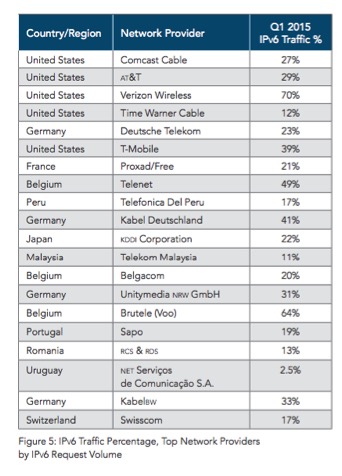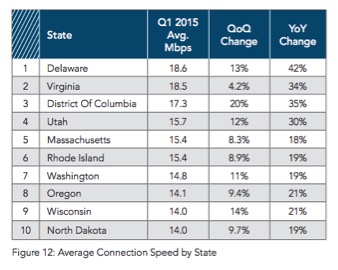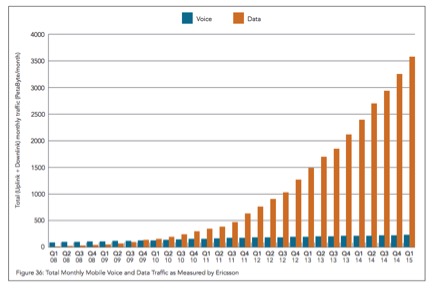What’s Up With the Internet?
Top Takeaways from Akamai’s 2015 Q1 State of the Internet Report
Number of Internet Users: 3.2 billion
Devices per Capita: ~2
2015 Broadband Threshold (set by FCC): 25 Mbps (up from 4 Mbps)
Country with Highest Average Connection Speed: South Korea
To paraphrase Jane Austen, “It is a truth universally acknowledged, that Internet speeds are slowest and mobile connectivity lowest when you can least afford it.”
These days, most of us in the United States, are avid consumers of content available on the Internet—whether it’s live-streaming a soccer game, downloading an e-book, or accessing a shared online space for work.
Unsurprisingly, it follows that the effectiveness and speed with which businesses are able to convey content through the medium of the Internet is a critical point by which they can live or die. This converging area of web performance, mobile performance, and media delivery is one that businesses are constantly monitoring and striving to improve in.
The gold standard for determining industry benchmarks and meaningfully measuring the issues and pitfalls around Internet-delivered content is the State of the Internet Report that Akamai has been releasing for the past eight years. Akamai has been studying web performance and related topics since 1999, and their much-vaunted quarterly reports are the gauge by which the industry judges online connectivity, cyber security trends, and metrics.
Akamai assesses the “state of the Internet” by tracking activity within its cloud-based Intelligent Platform service, which delivers massive amounts of data by virtue of its positioning on over 175,000 servers throughout the globe. The company’s software handles more than 2 trillion requests for web content daily, giving them a pretty good idea of the latest developments and trends in things like internet connection speeds, broadband adoption, mobile usage, outages, cyber attacks, and web security threats. Their report is free, available to the public, and in a genius example of content marketing is the perfect not-advertisement for their services.
That aside, the reports are must-read for businesses hoping to deliver content of any sort across the Internet. Unfortunately, they are typically lengthy and heavy on technical language. Fortunately, we read it for you!
While we won’t go into everything addressed in the report, here’s a quick summary of takeaways from the 2015 Q1 State of the Internet Report (in layman’s terms):
The Internet Has Run Out of Addresses
Internet protocol (IP) addresses are unique numbers that are assigned to any device accessing the Internet. Without these addresses, there is no way for devices to locate and communicate with each other. The current system known as IPv4 (Internet Protocol version 4) can only support 4.29 billion IP addresses, which have all been assigned.
Having foreseen this development, we are in the midst of adopting IPv6, which can support 2^128 Internet addresses and will keep us in business for a long, long time. The time and money required to change software and routers to make devices IPv6 compatible is the biggest obstacle to complete changeover.
Currently, IPv4 and IPv6 are running simultaneously through a process called dual stack. This should be the case for long enough that most organizations will be able to transition their devices over to IPv6 simply through attrition over time. See below for the percentage of IPv6 traffic currently running through major worldwide Internet carriers:
How Fast is Our Internet Really?
On the positive side, Akamai’s most recent report shows that Internet connection speeds are increasing quarter by quarter. And, hopefully, with the FCC’s new definition of broadband set at 25 Mbps from 4 Mbps, carriers will be encouraged to support the proliferation of faster, better networks, as there are no states currently reaching the new 25 Mbps threshold.
Akamai predicts “a strong likelihood of positive growth in average peak connection speeds throughout the U.S. going forward.” The report noted President Obama’s proposals to further broadband access, especially for rural areas, as well as the announcement of gigabit-speed Internet offerings like Google Fiber.
Looking across the 50 states and the District of Columbia, 42 states currently average connection speeds above 10 Mbps. Delaware saw the highest average connection speed of 18.6 Mbps, while Alaska was the lowest with 8.2 Mbps. Here are the top ten states for average connection speed:
On the Go
As our experience confirms, mobile data usage has skyrocketed in the last few years. The trend has not leveled off, but instead is showing growth each quarter. In fact, traffic grew around 12 percent between the fourth quarter of 2014 and the first quarter of 2015. The graphic below shows the strong increases data usage is seeing compared to the rather flat voice traffic:
So, there you have it. The latest state of the Internet. It seems safe to say that Internet connection speed and accessibility will continue to increase and improve (although never quite as quickly as we’d like), which will positively impact the efficiency and success with which Internet content can be provided and consumed.
Unfortunately, progress is somewhat impeded by the lack of competition among broadband providers, who seem content with the status quo as long as they’re still making money.
Also check out Akamai’s accompanying report on the State of the Internet – Security.
What Internet trends do you watch?
Let Us Know in the Comments Section Below!








